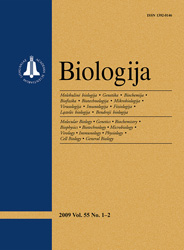Biologija / Biology
WHAT?
 ISSN 1392-0146 ISSN 2029-0578 (online) |
2006 m. Nr. 3 Investigation of human heart tissue extracts by
spectroscopic methods
The conduction system of the heart (HCS) is a type of muscular tissue which generates and transmits bioelectrical impulses. During surgical operations it is possible to harm HCS, since the common origin makes it hardly discernible for an unaided eye in the surroundings of ordinary myocardium (MC) or endocardium. The aim of this study was to reveal the protein composition differences between His bundle (HB) and MC tissues and to determine the distribution of fluorophores in these tissues. This in turn would help to visualize HCS by means of optical-fluorescence biopsy. It has been shown that fluorescence of the soluble fractions of heart tissues is mainly determined by tryptophan (W) and tyrosine (Y) residue emission, while fluorophores, responsible for the fluorescence in the visible region, were found to be hardly extractable from tissues and precipitated out as the insoluble fraction. According to SDS-PAGE, some protein groups specific to MC and HB were revealed. Some SDS-PAGE gel sections containing certain proteins of heart tissue fractions were investigated by spectroscopic methods. The results indicated that proteins of the same weight extracted from different heart tissues exhibit different fluorescence spectra.
Keywords: heart conduction system, His bundle, fluorescence spectroscopy, electrophoresis, protein composition |
Issues:
2011 - Vol.57 No. 1, No. 2, No. 3 2010 - Vol.56 No. 1-4 2009 - Vol.55 No. 1-2, No. 3-4 2008 - Vol.54 No. 1, No. 2, No. 3, No. 4 2007 - Vol.53 No. 1, No. 2, No. 3, No. 4 2006 No. 1, No. 2, No. 3, No. 4 2005 No. 1, No. 2, No. 3, No. 4 2004 No. 1, No. 2, No. 3, No. 4 2003 No. 1, No. 2, No. 3, No. 4 2002 No. 1, No. 2, No. 3, No. 4 2001 No. 1, No. 2, No. 3, No. 4 |